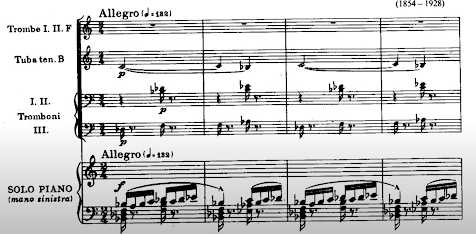Janacek loves tenor tuba
Today I want to focus on something that I only recently discovered. This is a work by Czech composer Leoš Janáček. This piece is likely the most unique piece that I’ll discuss on this blog. The piece is scored for piano soloist and chamber ensemble. The chamber ensemble is made up flute (doubling on piccolo), 2 trumpets, 3 trombones, and a “tenor tuba”. And on top of that odd ensemble, the piano solo is for left hand only!
The piece was composed for pianist Otakar Hollman, who was unable to use his right arm due to an injury he sustained during World World I. Watching the score fly by and imagining a virtuosic soloist performing with one hand is fascinating. But since this is a blog about brass ensembles, we’ll focus on this unique chamber ensemble from here on out.
The first movement primarily features the 3 trombones and tenor tuba. The trombones play short minor chords while the tenor tuba sustains long tones. The piano solo is very active while this is going on. It seems to me like the trombones are meant to cover for any mistaken or missed chords in the piano part.
The second movement uses a more call and response technique when it comes to the ensemble and soloist. The trombones and tenor tuba are once again the primary ensemble used during this movement. The trumpets are only introduced at specific moments. Halfway through this movement is when the flute is introduce in a quasi recitative solo.
The third movement begins with a short little theme from the tenor tuba, setting up the mood of this movement. Many of the instruments get solo opportunities in this movement, including trumpet, tenor tuba, and piccolo. As with the rest of the piece, the trombones are always acting as a section, never individuals.
The final movement is in sonata form and features many of the compositional techniques used in the previous movements. There are many challenging passages in the brass parts that require extensive technical facility. The ending of this piece is where the chamber ensemble really shines in terms of the texture. The piano has shimmering 16th notes while the trombones are sustaining and trumpets are multiple tonguing. The tenor tuba gets a few sweeping melodic figures in the upper tessitura that really gives that instrument a moment in the spotlight.
This is one of the most unique pieces I’ve ever encountered. I’d love to get a chance to perform it some day. I can’t believe there’s a piece dating back to 1926 that features a euphonium!
--
This week's euphonium in pop culture features the popular trivia account on TikTok. Thousands of people watch these videos daily and last year one of the questions was about which section the euphonium belonged to.
Enjoy!







Comments
Post a Comment